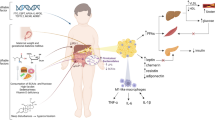Abstract
Background: Retinol-binding protein 4 (RBP4) is an adipocyte-derived ‘signal’ that may contribute to the pathogenesis of insulin resistance and Type 2 diabetes. The relationship of RBP4 with insulin resistance and metabolic risk in human beings has been the subject of several studies. Subjects born small for gestational age (SGA) are at risk of insulin resistance and Type 2 diabetes. Though RBP4 could represent an early marker of insulin resistance, to date, none have determined RBP4 in SGA children. Aim: Our aim was to measure RBP4 concentrations in cord blood of SGA newborns compared with those in children born with a birth weight appropriate for gestational age (AGA) and to determine whether serum RBP4 levels at birth correlate with insulin sensitivity markers. Subjects and methods: Sixty-four newborns, 17 born SGA (mean gestational age: 36.4±2.1 weeks), and 47 born AGA (mean gestational age: 37.0±3.6 weeks) were studied. The main outcome measures included anthropometry, lipid profile, insulin, homeostasis model assessment, quantitative insulin-sensitivity check index, adiponectin, and RBP4. Results: RBP4 concentrations were significantly reduced in SGA newborns (p<0.002). No relationship was found between RBP4 and insulin sensitivity parameters. Stepwise regression analysis revealed that birth weight was the major predictor of RBP4 serum concentrations (p<0.001). Conclusion: RBP4 is reduced in SGA newborns, birth weight representing the major determinant of RBP4 concentrations, and is not related to insulin sensitivity. No significant difference in adiponectin levels and insulin sensitivity markers was found between SGA and AGA neonates.
Similar content being viewed by others
References
Yang Q, Graham TE, Mody N, et al. Serum retinol binding protein 4 contributes to insulin resistance in obesity and type 2 diabetes. Nature 2005, 436: 356–62.
Graham TE, Yang Q, Blüher M, et al. Retinol-binding protein 4 and insulin resistance in lean, obese, and diabetic subjects. N Engl J Med 2006, 354: 2552–63.
Aeberli I, Biebinger R, Lehmann R, L’allemand D, Spinas GA, Zimmermann MB. Serum retinol-binding protein 4 concentration and its ratio to serum retinol are associated with obesity and metabolic syndrome components in children. J Clin Endocrinol Metab 2007, 92: 4359–65.
Barker DJ, Hales CN, Fall CH, Osmond C, Phipps K, Clark PM. Type 2 (non-insulin-dependent) diabetes mellitus, hypertension and hyperlipidemia (syndrome X): relation to reduced fetal growth Diabetologia 1993, 36: 62–7.
Geremia C, Cianfarani S. Insulin sensitivity in children born small for gestational age (SGA). Rev Diabet Stud 2004, 1: 58–65.
Saenger P, Czernichow P, Hughes I, Reiter EO. Small for gestational age: short stature and beyond. Endocr Rev 2007, 28: 219–51.
Hattersley AT, Tooke JE. The fetal insulin hypothesis: an alternative explanation of the association of low birth weight with diabetes and vascular disease. Lancet 1999, 353: 1789–92.
Yajnik CS, Lubree HG, Rege SS, et al. Adiposity and hyperinsulinemia in Indians are present at birth. J Clin Endocrinol Metab 2002, 87: 5575–80.
Wang X, Cui Y, Tong X, Ye H, Li S. Glucose and lipid metabolism in small-for-gestational-age infants at 72 hours of age. J Clin Endocrinol Metab 2007, 92: 681–4.
Bazaes RA, Salazar TE, Pittaluga E, et al. Glucose and lipid metabolism in small for gestational age infants at 48 hours of age. Pediatrics 2003, 111: 804–9.
Ghirri P, Ladaki C, Bartoli A, et al. Low birth weight for gestational age associates with reduced glucose concentrations at birth, infancy and childhood. Horm Res 2007, 67: 123–31.
Beltrand J, Verkauskiene R, Nicolescu R, et al. Adaptive changes in neonatal hormonal and metabolic profiles induced by fetal growth. restriction. J Clin Endocrinol Metab 2008, 93: 4027–32.
Gagliardi L, Macagno F, Pedrotti D, et al. Weight, length, and head circumference at birth of a Northeastern Italian population. Report of the ad hoc committee of the Italian Society of Neonatology. Riv Ital Ped 1999, 25: 59–169.
Lubchenco LO, Hansman C, Boyd E. Intrauterine growth in length and head circumference as estimated from live births at gestational ages from 26 to 42 weeks. Pediatrics 1966, 37: 403–8.
Gungor N, Saad R, Janosky J, Arslanian S. Validation of surrogate estimates of insulin sensitivity and insulin secretion in children and adolescents. J Pediatr 2004, 144: 47–55.
Hrebícek J, Janout V, Malincíková J, Horáková D, Cízek L. Detection of insulin resistance by simple quantitative insulin sensitivity check index QUICKI for epidemiological assessment and prevention. J Clin Endocrinol Metab 2002, 87: 144–7.
Klöting N, Graham TE, Berndt J, et al. Serum retinol-binding protein is more highly expressed in visceral than in subcutaneous adipose tissue and is a marker of intra-abdominal fat mass. Cell Metab 2007, 6: 79–87.
Chan TF, Chen HS, Chen YC, et al. Increased serum retinol-binding protein 4 concentrations in women with gestational diabetes mellitus. Reprod Sci 2007, 14: 169–74.
Laudes M, Oberhauser F, Bilkovski R, et al. Human fetal adiponectin and retinol-binding protein (RBP)-4 levels in relation to birth weight and maternal obesity. Exp Clin Endocrinol Diabetes 2009, 117: 146–9.
Beltrand J, Nicolescu R, Kaguelidou F, et al. Catch-Up growth following fetal growth restriction promotes rapid restoration of fat mass but without metabolic consequences at one year of age. PLoS One 2009, 4: e5343.
Ibanez L, Suarez L, Lopez-Bermejo A, Dıaz M, Valls C, de Zegher F. Early development of visceral fat excess after spontaneous catchup growth in children with low birth weight. J Clin Endocrinol Metab 2008, 93: 925–8.
Author information
Authors and Affiliations
Corresponding author
Rights and permissions
About this article
Cite this article
Giacomozzi, C., Ghirri, P., Lapolla, R. et al. Retinol-binding protein 4 in neonates born small for gestational age. J Endocrinol Invest 33, 217–221 (2010). https://doi.org/10.1007/BF03345782
Accepted:
Published:
Issue Date:
DOI: https://doi.org/10.1007/BF03345782



